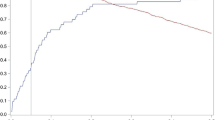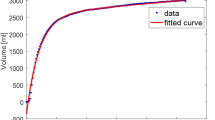Abstract
The aim of this retrospective study was to determine the utility of the spirometric measurements FVC, FEV1, and FEV1/FVC in diagnosing pulmonary restriction. Spirometry and lung volume measurements performed on the same patient visit were analyzed. The sensitivity, specificity, positive predictive value (PPV), and negative predictive value (NPV) of (1) FVC < lower limit of normal (LLN) (NHANES III reference values) and (2) FVC < LLN and FEV1/FVC ≥ LLN were compared to diagnose restriction based on lung volume measurements. In all, 18,282 pulmonary function tests from 8,315 patients were analyzed. Twenty-six percent of the patients (n = 2,213) had restriction based on lung volume measurements. The sensitivity, specificity, PPV, and NPV of FVC < LLN to diagnose restriction based on lung volume measurement criteria were 88.6%, 56.8%, 39.9%, and 93.9%, respectively. The sensitivity, specificity, PPV, and NPV of FVC < LLN and FEV1/FVC ≥ normal to diagnose restriction based on lung volume criteria were 72.4%, 87.1%, 64.4%, and 90.7%, respectively. Analysis of ROC curves showed that spirometric criteria based on FVC alone performed better (area under the curve = 0.817) than those based on the combined criteria of FVC and FEV1/FVC (area under the curve = 0.584). Consistent with earlier findings, the negative predictive value for a normal FVC (≥ LLN) to exclude pulmonary restriction was high in this series (up to 95.7%). Also, a spirometric diagnosis of “restriction” (FVC < LLN and FEV1/FVC ≥ LLN) had a positive predictive value of 26.3–73.9%. On this basis, normal FVC can be regarded as excluding restriction with high reliability.

Similar content being viewed by others
References
Crapo RO (1994) Pulmonary function testing. N Engl J Med 331:25–30
Aaron SD, Dales RE, Cardinal P (1999) How accurate is spirometry at predicting restrictive pulmonary impairment? Chest 115:869–873
American Thoracic Society (1995) Standardization of Spirometry, 1994 Update. Am J Respir Crit Care Med 152:1107–1136
Hankinson JL, Odencrantz JR, Fedan KB (1999) Spirometric reference values from a sample of the general U.S. population. Am J Respir Crit Care Med 159:179–187
Crapo RO, Morris AH, Clayton PD, Nixon CR (1982) Lung volumes in healthy nonsmoking adults. Bull Eur Physiopathol Respir 18:419–425
Knudson RJ, Lebowitz MD, Holberg CJ, Burrows B (1983) Changes in the normal maximal expiratory flow-volume curve with growth and aging. Am Rev Respir Dis 127:725–734
Enright PL, Kronmal RA, Higgins M, Schenker M, Haponik EF (1993) Spirometry reference values for women and men 65 to 85 years of age. Cardiovascular health study. Am Rev Respir Dis 147:125–133
Glady CA, Aaron SD, Lunau M, Clinch J, Dales RE (2003) A spirometry-based algorithm to direct lung function testing in the pulmonary function laboratory. Chest 123:1939–1946
Boros PW, Franczuk M, Wesolowski S (2004) Value of spirometry in detecting volume restriction in interstitial lung disease patients. Respiration 71:374–379
Author information
Authors and Affiliations
Corresponding author
Additional information
Saiprakash B. Venkateshiah and Octavian C. Ioachimescu authors contributed equally to this work.
Appendix
Appendix
The appendix includes tables that evaluate spirometric criteria for restriction with various lung volume measurement definitions of restriction for the entire database, including repeated mesurements on the same patients.
Rights and permissions
About this article
Cite this article
Venkateshiah, S.B., Ioachimescu, O.C., McCarthy, K. et al. The Utility of Spirometry in Diagnosing Pulmonary Restriction. Lung 186, 19–25 (2008). https://doi.org/10.1007/s00408-007-9052-8
Received:
Accepted:
Published:
Issue Date:
DOI: https://doi.org/10.1007/s00408-007-9052-8




